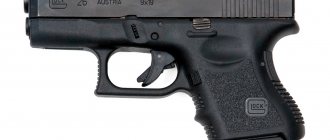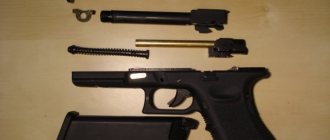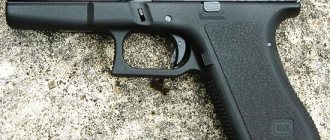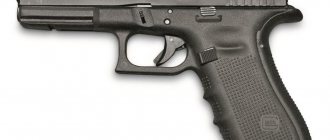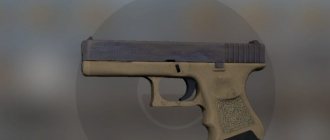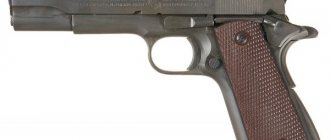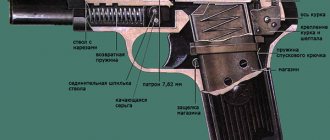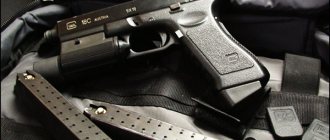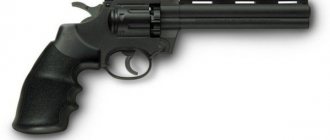The series of short-barreled weapons, which have been produced since 1982 by the Austrian company Glock, has become a kind of revolution in the arms business. It was the first to widely use polyamide not only for decorative, but also structurally loaded parts. Lightweight, compact, they consist of only 33 parts, including the clip. A number of design solutions - for example, a triple-action fuse, the absence of a trigger - made it possible to expand the scope of its use from military to self-defense weapons. Weapons companies producing airsoft weapons could not ignore such a popular brand. The Taiwanese company WE has released an airsoft version of the compact Glock 19 Gen 4, almost indistinguishable in appearance and as simple in design as its firearm prototype.
Air pistol Glock 19 Gen 4 from WE
This is an airsoft pistol that shoots plastic balls with a diameter of 6 mm. Liquefied natural gas (green gas) is used as an energy source for firing, pumped into a special compartment of the clip.
Advantages and disadvantages
The pistol is so similar to its prototype that you can understand its airsoft nature only by picking up the weapon. A characteristic long handle made of polyamide with pimpled corrugation and three small anatomical recesses for the fingers, a trigger combined with an automatic safety lever, an angular trigger guard, no hammer, a parallelepiped-shaped bolt frame with “slicked” corners.
The differences start at the labeling level. For example, on the left side of the bolt frame of Glock 19 pistols, at the muzzle, there is only a stylized letter G, the rest of the word - lock - is missing. On the right side of the slide, above the handle, the designation of the country of origin has been replaced - from Austria to a pair of hieroglyphs. Under this inscription, already on the body of the pistol, it is also indicated that “made in Taiwan.”
The airsoft WE Glock 19 Gen 4 is half made of impact-resistant plastic - only the bolt frame is steel. It is doubtful that this is the same type of polyamide used in the original, but it is strong enough, and therefore this design feature of the replica cannot be considered a disadvantage.
The airsoft pistol repeats all the functional features of the original - blowback, active release lever, bolt frame locking lever (button). Even the design of the return spring installation with a characteristic outer protrusion, similar to a “second barrel”.
As in the original, on the body in front of the trigger guard there is a kind of dovetail strip for attaching a flashlight or laser pointer.
Everything would have been perfect, but the Taiwanese managed to add a fly in the ointment. The most important firing part of the pistol is the gas chamber, which provides loading and supply of gas to the barrel and is made of polymer for the “blowback” effect. At a high rate of fire (Glock does not fire in bursts; the rate of fire is determined by your ability to quickly press the trigger), scuffing may occur on the guides of the gas chamber and on the nose sticking into the hop-up hole.
It’s also bad that the absence of a trigger does not allow you to remove the pistol from cocking without special manipulations - removing the clip, control triggering and other tricky actions. But - this is a family feature of all Glock pistols.
Photo of the Glock 19 air pistol
Where is it used?
Despite the complete external similarity of the airsoft version with the compact self-defense weapon Glock 19 Gen 4, WE’s product can only be used for team sports and target shooting at a shooting range.
All modifications of Glock system pistols
Currently, a generation of weapons of this system has been created with many modifications of Glock pistols:
- Glock 17L model 1988, which has an extended barrel;
- Glock 17C modification with a muzzle brake that reduces recoil during a shot;
- The Glock 17R has a plastic frame and is designed for training using non-combat ammunition;
- Glock 17T modification for training shooting; colorful markers are used instead of cartridges.
Next came the models under serial numbers:
- – equipped with a firing mode translator, which makes it possible to fire in bursts.
- 19 – compact with a shortened barrel;
- 20 – fires 10 mm caliber cartridges;
- 21 – designed for 45 ACP cartridges, has an octagonal barrel;
- 22 – made for American 40 S&W cartridges, the modification is used as a service weapon for FBI agents;
- 23 – a shortened version of the 22, also used by operational staff;
- 24 - one of the modifications of model 22, which has an elongated barrel and increased accuracy of fire;
- 25 – a compact variation of the 22 model, 9x17 mm caliber, intended for civil self-defense;
- 26 – compact version of the first model with 10 rounds;
- 27 - pistol designed for 40 S&W cartridges with 9 units in the magazine;
- 28 – compact version of model 25;
- 29 – shortened version of model 20;
- 30 – compact model version 21;
- 31 – modification of the first model for caliber 357 SIG;
- 32 – a smaller version of the previous one, having a smaller magazine volume;
- 33 – a significantly smaller version of model 31;
- 34 – one of the modifications of the first model, equipped with an elongated barrel and having increased accuracy of fire;
- 35 – a modified version of the 22 model, designed for training personnel;
- 36 - a compact version of the 21, which has a 6-round magazine with a single-stack arrangement and greatly facilitates concealed carry;
- 37 – version of the original model, designed for .45 GAP cartridges;
- 38 – a smaller version of the previous one with a smaller magazine;
- 39 – a significantly smaller version of the 37 model;
- 40 – semi-automatic pistol of 10mm Auto caliber;
- 41 – modification of model 21 with caliber 45 ACP and increased barrel length;
- 42 – identical to model 26, but has a smaller thickness and single-row placement of 9x17 caliber cartridges;
- 43 is a compact version of the 26, having a single-stack magazine with 6 rounds of 9x19 caliber.
Glock 17
It has proven itself to be a reliable and unpretentious weapon; several generations of the Glock 17 have been produced over the years. The pistol has 34 parts with a magazine. It is quickly and easily disassembled, its length is 18.6 cm, the barrel length is 11.4 cm, the initial bullet speed is 375 m/sec, the destruction range is 50 meters.
Glock 19
In 1988, the company released a smaller version of the first pistol, the Glock 17 Compact, which two years later was renamed the Glock 19.
Unlike model 17, it has a shorter barrel and handle, as well as a smaller magazine capacity.
In addition to the main model, a version of the Glock 19C was released, which has reduced recoil due to the muzzle brake and holes in the bolt casing.
Pistols Glock 17, Glock 19 and Glock 26 – Review and detailed information
The most compact model in the line is the Glock 19 Gen 4 pistol, which has a 15-round magazine in 9x19 caliber. It can be used both for sports shooting and for self-defense.
Glock 19X
In 2022, a version of the pistol was released that was significantly different from all previous ones by the company - Glock 19X. The new pistol has a Model 19 slide and barrel, as well as the long grip of the very first Model 17.
The valve features an advanced coating that protects against corrosion, harmful chemicals and the environment.
The Glock 19X features a full Coyote finish and no finger grooves, but does feature a lanyard loop.
The pistol has a caliber of 9x19, the kit includes one standard magazine for 17 rounds and two for 19.
Other versions of Glock
Many released variants have additional modifications, designated C and L. They differ slightly from the original model, mainly in length or weight.
Throughout history, several generations have been released, each of which reflected significant innovations as technology developed and became more convenient than the previous one.
Accessories and additions to the pistol
The variety of Glock pistols makes it possible to equip the weapon with a wide variety of accessories and tuning options.
You can install a removable sight, put a luminous dot on the front sight, attach a tactical flashlight or laser target designator.
The pistol also comes with additional grips, lighter bolt carriers, suppressors, larger clips, or complex systems that will turn the Glock into a compact close-quarters submachine gun.
Specifications
Technical characteristics of Glock 19 air pistols:
| Characteristics | Indicators |
| Analogue | Glock 19 Gen 4 Austria |
| Manufacturer | WE Company Taiwan |
| Mechanism type | Gas |
| Gas type | Liquefied natural gas (green gas) |
| Caliber, mm | 6 |
| Trunk | Brass, smooth |
| Hop-up | adjustable |
| Ammunition | Plastic ball 6 mm |
| Clip capacity | 19 balls |
| Blowback | Eat |
| Material | Metal, plastic |
| External device bracket | Under-barrel, dovetail |
| Initial shot speed, m/s | 90-110 |
| Shooting mode | Single |
| Fuse | Auto |
| Effective firing range, m | 25 |
| Maximum ball flight range, m | 40 |
| Overall length, mm | 185 |
| Height, mm | 127 |
| Weight of loaded pistol with gas, g | 720 |
History of the Glock pistol
The first combat pistol that was released by Glock GmbH in 1980 was the Glock 17. The main goal of the Austrian engineer and company owner Gaston Glock was to create a simple, effective and reliable pistol. The company's designers used advanced technical solutions at that time.
Glock pistol. TV program. Weapons TV
The new pistol was lightweight, had a large magazine volume, was safe and reliable in operation, and had high strength. The developed model showed excellent results and after 2 years the new model was adopted by all security forces in Austria.
Later it began to be used by law enforcement agencies in other European countries. This compact model is valued by the police and intelligence agencies, especially by employees who work in plain clothes and need to carry a concealed weapon.
Over time, the company began producing other models and various modifications of Glock pistols, equipping them with significant innovations that increase convenience and reliability.
Design
Externally, it is indistinguishable from the prototype - Glock 19 Gen 4. The bolt frame is steel, the body and trigger mechanism are made of impact-resistant plastic. The effect of a blowback is simulated, setting the shutter to a delay when the magazine is empty (19 plastic balls with a diameter of 6 mm). The automatic safety lever is combined with the trigger.
The combat mechanism is gas, using liquefied natural gas (green gas) from cylinders for refilling lighters. The gas compartment is connected to the holder.
Single action trigger. Shooting after the first jerk of the shutter (cocking) in semi-automatic mode (self-cocking). The fuse is automatic, but there is no triple degree of protection, as in the original. There is no trigger, so it is almost impossible to uncock the pistol without firing.
The barrel is smooth, brass, internal diameter 6.2 mm, length 110 mm. Hop-up is adjustable. To get to the adjustment wheel, partial disassembly of the gun is required.
Operating principle
The clip is removed by pressing the button at the base of the trigger guard. It is loaded with nineteen plastic balls with a diameter of 6 mm (the weight can be different, at the choice of the shooter) through the upper loading hole. At the bottom of the holder there is an inlet pipe for the gas compartment. It is used for filling with natural liquefied gas (green gas). The exhaust valve rod, which the trigger striker strikes, is also located on the holder, at the back, at the top. It is more convenient to fill with gas if the clip is installed in the pistol handle.
After installing the loaded clip, the bolt frame jerks and the pistol is ready to fire. The backward movement of the bolt frame is accompanied by a shift in the receiving window of the gas chamber. It is plastic and is integral with the nozzle, which fits tightly into the hole of the hop-up device. One ball is popped out of the gas chamber window. When the bolt frame returns back, the barrel and gas chamber are connected into a single unit.
Pulling the trigger disengages the automatic safety as the lever is aligned with it. The firing pin breaks off the sear stops and hits the valve stem of the gas compartment of the holder, opening it. The liquefied gas sublimes (turns into a gaseous state) and enters the gas chamber.
The gas simultaneously presses on the ball in the hop-up, pushing it along the barrel, and on the rear wall of the gas chamber, forcing it, along with the bolt frame, to move backward (blowback). The bolt frame, moving backward, cocks the hammer, and then returns back, along the way picking up the ball from the clip and connecting the neck of the gas chamber (nozzle) with the barrel. The firing cycle is complete. It can be repeated by pressing the trigger until the clip is completely empty.
MHS: intrigues, scandals, investigations
The program to adopt the new main pistol of the US Army and US Air Force was called the Modular Handgun System. The process of selecting a pistol to replace the Beretta M9 and SIG Sauer M11 (P228) lasted for 13 years. The active phase of the competition, which included testing samples, began in 2015. The terms of the competition did not indicate the exact number of pistols that were planned to be purchased. But it was stipulated that the participants also had to supply the troops with ammunition for pistols. The following Glock pistols took part in the competition: G17MHS and G19MHS in 9x19 caliber, as well as G22MHS and G23MHS in .40 S&W caliber. Beretta entered its APX model into the competition, although many were confident that they would enter the M9A3 pistol, which, according to the . CZ provided the P-07 MHS and P-09 MHS for the competition in 9x19 and .40 S&W calibers, respectively. FN USA decided to participate in the competition with the FNS pistol, KRISS USA exhibited a modification of its Sphinx SDP. The SIG Sauer concern presented the P320 MHS pistol. Smith & Wesson offered a version of the M&P2.0 model. The Turkish Canik TP40AF and the German H&K VP40 also took part in the competition. It is noteworthy that some companies never spoke publicly about participating in the MHS competition or did not show the pistols they submitted to the Army for testing to the general public.
The final dates for submitting weapons to the competition have changed, and the budget has been cut repeatedly. The constant changes in mood and uncertainty of the commission were expressed in the fact that in early 2016 it was announced that the .40 S&W caliber was preferable to 9x19 - and all companies that did not present an option in this caliber were eliminated from the competition. This is a funny moment, considering that the caliber was not specified in the technical specifications. It was only stipulated that the required terminal ballistics (which can be roughly interpreted as “lethal effect”) must exceed that of the standard 9 mm M882 cartridge (with an FMJ bullet). Another funny episode was associated with the statement of the US Army Chief of Staff, General Mark Miley, that the program for selecting and testing a new pistol is so drawn out and expensive that it would be cheaper to provide every infantryman, pilot and sailor with pistols for the cost of the program itself by simply purchasing them in the store. The general made this speech on a talk show on national television. Miley also suggested that everyone buy the Glock 19 model, since the US Marine Special Operations Command (MARSOC) approved this pistol, purchasing it for the NAVY SEALs, and further implementation of the MHS is simply a waste of money.
Beretta M9
According to the results of the MHS competition, the victory was given to the model from SIG Sauer. Glock filed a protest with the US Government Accountability Office (GAO), which was forced to prove that the money allocated for the purchase of new weapons would not be wasted. Glock said the competition ended improperly and nearly a year ahead of schedule—and that a basic reliability test was not conducted. There was a 17-page official response to this, saying that the Glock and SIG Sauer samples were virtually identical in reliability based on the tests that had already been conducted, and that the Glock received a lower score for ergonomics in the only subjective test of all. The main reason was that it turned out to be more expensive, and even the proposal to reduce the price of the pistol by eliminating several levels of quality control during production did not change the commission’s opinion. It should be noted that in order to participate in the competition, SIG Sauer entered into an agreement with Winchester, one of the largest ammunition manufacturers, which made it possible to significantly reduce the price and expand the supply of cartridges that was part of the contract.
US Army Rangers adopted the Glock 19
The competition ended, and SIG Sauer pistols with the designations XM17 and XM18 (compact version) had already begun to enter the troops, when suddenly a scandal broke out regarding the insufficient reliability of the SIG Sauer P320 system - the pistols fired spontaneously when dropped. Last summer, a highly publicized lawsuit was filed by a Connecticut police officer whose P320 fired while in a holster on his equipment belt. The police officer was opening the trunk of his patrol SUV, the belt fell, and as he fell to the ground, the gun went off, seriously wounding the law enforcement officer. The SIG Sauer company stated that this is only possible in civilian modifications of pistols, and announced a program for returning weapons for modification. All this public scandal took place against the backdrop of another high-profile lawsuit: the Austrian company Steyr Mannlicher sued SIG Sauer for patent infringement: it was stated that the modular system that SIG used for its pistols was patented by Steyr back in 2001.
Glock 23 MHS in .40 S&W
The trials continue, and the military personnel already have pistols, and it will be very interesting to see how this all ends.
Disassembly
Disassembly of the WE G19 can be partial, for maintenance, or complete, if you need repairs or upgrades.
Partial disassembly is performed in the following order:
- Remove the clip.
- Using the thumb and index finger of your left hand, press down the buttons above the trigger guard (recessed into the body).
- Simultaneously with this movement, lift the rear part of the bolt frame and move it all forward, removing it from the barrel.
- Remove the return spring along with the rod and stop (cannot be disassembled).
- Remove the outer decorative trunk along with the inner one.
- Remove the inner brass barrel (the hop-up mechanism is secured with two screws).
Glock 19 after partial disassembly
For complete disassembly you need:
- Carry out partial disassembly.
- At the rear of the bolt frame, unscrew one screw and remove the bracket along with the gas chamber. At the same time the rear sight will be removed.
- Remove the shock-absorbing springs on the gas chamber bracket and remove it.
- Press out the trigger pin on the body (located above it).
- Unscrew the internal Phillips screw and remove the trigger with the safety lever and cocking rod.
Upgrade
The only thing that can be upgraded in this pistol is the hop-up mechanism. The improvement allows you to press the rubber band closer to the ball and twist it, as a result of which the ball’s flight path will become flatter and the shooting will be more accurate.
We perform partial disassembly of the pistol. Next, let's look at the hop-up mechanism:
- Unscrew the two screws on the left, separate the halves of the mechanism;
- remove the barrel, eccentric wheel;
- remove the U-shaped steel fork from the barrel that rests on the hop-up elastic band.
After this operation, you need to drip solder onto the inside of the U-shaped fork and trim the resulting protrusion so that it matches the shape and size of the rubber band in the barrel.
With this trick you increase the influence of the eccentric wheel, which in the stock version may not be enough to effectively tighten the rubber.
Glock equipment
The weapon is packed in a cardboard box with the image of the English letter “G”. The kit includes:
- User manual.
- Gun.
- Keys for adjustment.
- Shop.
- Two plastic back handles for adjusting the girth.
All components are contained in a foam compartment.


